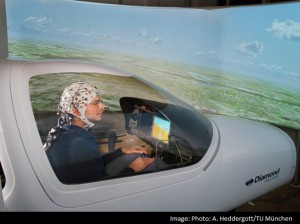 Imagine pilots of the future who can control aircraft by merely thinking commands?
Imagine pilots of the future who can control aircraft by merely thinking commands?
This is not a scene from a science fiction movie but the scientists have achieved the feasibility of flying an aircraft via brain control – with astonishing accuracy.
Here, the pilot is wearing a white cap with myriad attached cables. His gaze is concentrated on the runway ahead of him. All of a sudden, the control stick starts to move, as if by magic.
The airplane banks and then approaches straight on towards the runway. The position of the plane is corrected time and again until the landing gear gently touches down.
During the entire manoeuvre, the pilot touches neither pedals nor controls.
“A long-term vision of the project is to make flying accessible to more people,” explained aerospace engineer Tim Fricke, who heads the project at the Institute for Flight System Dynamics of the Technische Universitat Munchen (TUM).
“With brain control, flying, in itself, could become easier. This would reduce the work load of pilots and thereby increase safety. In addition, pilots would have more freedom of movement to manage other manual tasks in the cockpit,” Fricke added.
During the experiment, seven subjects took part in the flight simulator tests.
They had varying levels of flight experience, including one person without any practical cockpit experience whatsoever.
The accuracy with which the test subjects stayed on course by merely thinking commands would have sufficed, in part, to fulfil the requirements of a flying license test.
“One of the subjects was able to follow eight out of 10 target headings with a deviation of only 10 degrees,” Fricke noted.
Several of the subjects also managed the landing approach under poor visibility. One test pilot even landed within only few metres of the centreline.
In order for humans and machines to communicate, brain waves of the pilots are measured using electroencephalography (EEG) electrodes connected to a cap.
Only the very clearly defined electrical brain impulses required for control are recognised by the brain-computer interface.
“This is pure signal processing,” emphasises Fricke, adding that “Mind reading is not possible.”
Source-NDTV


